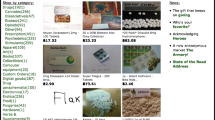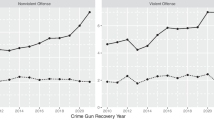Abstract
This research, based primarily on financial records of Colombian money smugglers found by Dutch police investigators, describes the costs and operations of a segment of the high-level drug trade not previously documented in the scholarly literature. Cocaine traffickers pay brokers to move their revenues from the Netherlands to Colombia. The transfers, almost all in 500 euro notes, amount to hundreds of million of euros annually during the period 2003–2008 and drew on the recruitment of hundreds of individuals not otherwise involved in the drug trade. The total cost of the service (bulk cash smuggling) is over 10 % and could be as high as 17 %. These data also shed light on the workings of criminal labor markets and point to some interesting imperfections. The existence and cost of this segment of the cocaine trade suggests that anti money laundering regulations, and perhaps drug enforcement generally, do significantly raise the costs of smuggling, though not of the retail price. The findings also are evidence of the importance 500 euro notes played in facilitating the drug trade, a claim often made but never previously documented (While the article was under review, the European Central Bank (ECB) came to the decision to phase out the 500 euro note. Also see https://www.ecb.europa.eu/press/pr/date/2016/html/pr160504.en.html).

Similar content being viewed by others
Notes
In a related paper in Dutch, a slightly smaller figure was found because a few extra confiscated notes were later added to the original file; see Soudijn [19].
The term ‘money broker’ is used by the police. It is unclear if they actually go by this name. Their function, however, seems similar to the money brokers in the Black Market Peso Exchange, who allow drug sales dollars in the US to be used by Colombian businesspeople there, who in turn deposit Colombian currency in Colombia, bypassing exchange controls [25–27].
However, the legal consequences of being charged with importing money are far greater than the couriers themselves estimate. Not only can money couriers be charged with money laundering in the Netherlands and sentenced to 2 years’ imprisonment, but the South American authorities do not consider money smuggling a minor offense either.
This may suggest that the operations were slow in sending the money as the average seizure of money at the facility was more than 1 week’s volume. However it should be noted that some of the investigations were triggered by events that themselves were triggered by arrivals of large sums, for example an attempted theft. Moreover, arrivals were lumpy (multi-millions of euros) while shipments are much smaller (200–450,000 euros), so that even a randomly timed raid might turn up large amounts of cash.
In at least two cases the price of tickets recorded in the coordinator’s statements is higher than the figure the police found in the travel agency records. Whether the travel agency was cheating the tax authority or the coordinator is impossible to determine.
Affidavit of Jaime X.Cepero, in Federal District Court of Massachusetts, 9 August 2013 http://cf2.100r.org/media/2014/09/narco-cash-flowed-thru-citi-deutsche-bank-and-bofa-court-papers-say/DEA-Affidavit-Money-Laundering-Case.pdf.
$20 billion is a high end estimate of the total export earnings of Mexican drug dealers. For a systematic analysis that produces a substantially lower figure see Kilmer et al. [35]
References
Zaitch, D. (2002). Trafficking cocaine: colombian drug entrepreneurs in the Netherlands. Den Haag: Kluwer Law International.
Mazur, R. (2009). The infiltrator: my secret life inside the dirty banks behind Pablo Escobar’s Medellin Cartel. New York: Little, Borwn and Company.
Cornish, D. B., & Clarke, R. V. (2002). Analyzing organized crimes. In S. G. T. A. R. Piquero (Ed.), Rational Choice and criminal behavior. Recent research and future challenges. New York: Routledge.
Cornish, D. B. (1994). The procedural analysis of offending and its relevance for situational prevention. In R. V. Clarke (Ed.), Crime prevention studies (Vol. 3, pp. 151–196). Monsey (NJ): Criminal Justice Press.
Matrix Knowledge Group (2007). The illicit drug trade in the United Kingdom, 2nd edition, London: Home Office. Online Report 20/07.
UNODC, World Drug Report (2013) United Nations publication, Sales No.E.13.XI.6. http://www.unodc.org/unodc/secured/wdr/wdr2013/World_Drug_Report_2013.pdf. Accessed 27 June 2016.
Paoli, L., Greenfield, V. A., & Reuter, P. (2009). The world heroin market: Can supply be cut? Oxford: Oxford University Press.
Reuter, P. (2013). Are estimates of the volume of money laundering either feasible or useful? In E. Elgar (Ed.), Research handbook on money laundering (pp. 224–231). Cheltenham: Edward Elgar.
Gilmore, W. (2004). Dirty money (3rd ed.). Strasbourg: Council of Europe.
Levi, M. (2013). Drug law enforcement and financial investigation strategies (report no. 5). London: IDPC - International Drug Policy Consortium.
Benschop, A., Nabben, T., & Korf, D. J. (2012). Antenne 2012: Trends in Alcohol, Tabak en Drugs bij jonge Amsterdammers [antenna 2012: trends in alcohol, tobacco and drugs by young people from Amsterdam]. Amsterdam: Rozenburg Publishers.
Caulkins, J. P., Johnson, B., Taylor, A., & Taylor, L. (1999). What drug dealers tell us about their costs of doing business. Journal of Drug Issues, 29(2), 323–340.
Caulkins, J. P., & Reuter, P. (1998). What can we learn from drug prices? J. Drug Issues, 28(3), 593–612.
Reuter, P., MacCoun R., and Murphy, P. (1990). Money from crime: a study of the economics of drug dealing in Washington, D.C. The RAND Corporation, R-3894-RF, June 1990.
Decker, S. H., & Chapman, M. T. (2008). Drug smugglers on drug smuggling Philadelphia. Temple University Press.
Europol (2015). Why is cash still king? A strategic report on the use of cash by criminal groups as a facilitator for money laundering. The Hague: Europol.
Farah, D. (2010). Money Laundering and bulk cash smuggling: challenges for the merida initiative. In Woodrow Wilson Center for international studies. Trans-Border Institute: University of San Diego.
FATF and MENAFATF (2015) Money laundering through the physical transportation of cash, FATF Paris, France and MENAFATF, Manama, Bahrain www.fatf-gafi.org/publications/methodsandtrends/documents/ml-through-physical-transportation-of-cash.htm
Soudijn, M. (2013). Illegale geldverplaatsingen vanuit Nederland naar Colombia: een analyse van criminele administratieve gegevens. In D. Boels, L. Bisschop, E. Kleemans & K. van der Vijver (Eds.), Illegale en informele economie (pp. 231–264). Apeldoorn: Maklu.
Levitt, S., & Venkatesh, S. (2000). An economic analysis of a drug-selling Gang's finances. The Quarterly Journal of Economics, 115(3), 755–789.
Soudijn, M. R. J., & Zhang, S. X. (2013). Taking loan sharking into account: a case study of Chinese vest-pocket lenders in Holland. Trends in Organized Crime, 16(1), 13–30.
Bahney, B., Shatz, H. J., Ganier, C., McPherson, R., & Sude, B. (2010). an economic analysis of the financial records of al-Qa'ida in Iraq. Santa Monica: RAND Corporation.
FATF/MENAFATF. (2015). Money laundering through the physical transportation of cash. Paris: Financial Action Task Force/Middle East & North Africa Financial Action Task Force.
FATF/OECD (2010). Global Money Laundering & Terrorist Financing Threat Assessment: A view of how and why criminals and terrorists abuse finances, the effect of this abuse and the steps to mitigate these threats. Paris: Financial Action Task Force/The Organisation for Economic Co-Operation and Development.
FATF/OECD (2006). Trade Based Money Laundering. Paris: Financial Action Task Force/The Organisation for Economic Co-Operation and Development.
GAO (2003). Terrorist financing: U.S. Agencies Should Systematically Assess Terrorists’ Use of Alternative Financing Mechanisms (report to congressional requesters) no. GAO-04-163. Washington: United States General Accounting Office.
McCarthy, D. M. P. (2011). An economic history of organized crime. New York: Routledge.
Fuentes, J.R. (1998). The life of a cell: managerial practice and strategy in colombian cocaine distribution in the United States. Ph.D. Dissertation, City Universtiy of New York.
Soudijn, M. R. J. (2014). A critical approach to trade-based money laundering. Journal of Money Laundering Control, 17(2), 230–242.
FATF/OECD (2013). The role of hawala and other similar service providers in money laundering and terrorist financing. Paris: Financial Action Task Force/The Organisation for Economic Co-Operation and Development.
Passas, N. (1999). Informal value transfer systems and criminal organizations: a study into so-called underground banking networks. Den Haag: WODC.
Passas, N. (2005). Informal value transfer systems and criminal activities. Cahier 2005–1. Den Haag: WODC.
Thompson, E.A. (2007). “The nexus of drug trafficking and Hawala in Afghanistan” in Buddenberg, D and W. Byrd. Afghanistan’s drug industry, UNODC and the World Bank.
Maimbo, S.M. (2003). The money exchange dealers of Kabul: a study of the Hawal system in Afghanistan / World Bank working paper; no. 13.
Kilmer, B., Caulkins, J.P., Bond, B. and Reuter, P. (2010) Reducing drug trafficking revenues and violence in Mexico: would legalizing marijuana in California help? RAND Occasional Paper http://www.rand.org/pubs/occasional_papers/2010/RAND_OP325.pdf
Pollack, H. A., & Reuter, O. (2014). Does tougher enforcement make drugs more expensive? Addiction, 109(12), 1959–1966.
Williams, P. (2001). Transnational criminal networks. In J. Arquilla & D. Ronfeldt (Eds.), Networks and netwars: the future of terror, crime, and militancy (pp. 61–97). Santa Monica, CA: Rand Corporation.
Desroches, F. (2007). Research on upper level drug trafficking: a review. Journal of Drug Issues, 37(4), 827–844.
Graham, C., and Luck, A. (2010). How the 500 euro is financing a global crime wave of cocaine trafficking, the black market and tax evasion Mail on Line 30 January. http://www.dailymail.co.uk/home/moslive/article-1246519/How-500-euro-financing-global-crime-wave-cocaine-trafficking-black-markettax-evasion.html. Accessed 27 June 2016.
Rogoff, K., Giavazzi, F., & Schneider, F. (1998). “Blessing or curse? Foreign and underground demand for euro notes” Economic Policy. EMU pp., 13(26), 261–303.
Acknowledgments
We would like to thank Jonathan Caulkins, Edward Kleemans, Michael Levi, Letizia Paoli, Ben Vollaard and Damian Zaitch for helpful comments on a draft.
Author information
Authors and Affiliations
Corresponding author
Rights and permissions
About this article
Cite this article
Soudijn, M., Reuter, P. Cash and carry: the high cost of currency smuggling in the drug trade. Crime Law Soc Change 66, 271–290 (2016). https://doi.org/10.1007/s10611-016-9626-6
Published:
Issue Date:
DOI: https://doi.org/10.1007/s10611-016-9626-6




